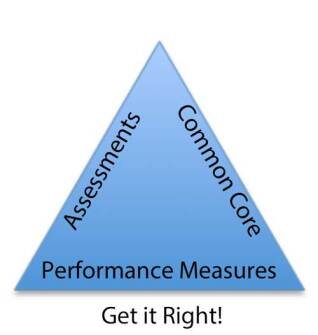Assessments of students, teachers, and principals took center stage all of last year and will continue to remain there moving ahead. Many of us are trapped in resistance. If we allow ourselves to enter that abyss, we give our efficacy away. Perhaps, those who raise the voices of opposition will be triumphant and the mandates will be changed. We give them our support. But, for those among us who are innovative and optimistic, there must be a different path or we risk succumbing to the cynicism and fatigue that characterizes so many right now. If there is summer work to be done, it must be for leaders. They cannot return to schools in the fall in that weakened state of mind.
Change was needed. In our cities, 50% of the students fail to graduate. While rates vary and we can debate how graduation rates are calculated, a large number of those who enter ninth grade do not graduate four years later. ED.gov reports statewide graduation rates of between 62 and 88 percent for students four years after entering high school. Other reports indicate rates a bit lower that 62 and higher than 88 percent, but all indicate the problem. You can find your state’s rating on Education Week’s interactive map. Regardless of how hard we are trying and how much progress we have made, it is not enough. Can we really make a credible argument against those who want us to do better?
We know too well the profile of those students who are not finishing. There exists a growing achievement gap among the students even as they enter our kindergartens. So Presidents, Congress, Commissioners of Education, State Boards and Governors put pressure on the system, increasing accountability measures while decreasing resources. They demand that we measure everything, everyone, and often. After a couple of years of arguing about who gets to choose the assessments, how often they are given, it was done. Now, it has passed to our hands, ready or not. Schedules had to be developed, classroom time was diminished, new assessments had to be developed or bought, data was available and we had to learn more about using the data to inform and change the instruction in our classrooms. The results not only measured students’ growth or achievement, it was linked to teacher and principal evaluations. All new. All flawed. But something had to be done. What choice remains ours?
A short video suggests an answer we embrace. It is the story of a triangle and children They are given a triangle and asked two subtly different sets of direction that yield very different results. The first direction is to complete picture the right way; if they do they will receive one point. The second is to complete the picture. When the implication of a right answer and a miniscule reward, is presented, the children used fewer colors and were more restrained in their thought. When those three simple, but powerful, words were removed, creativity flourished.

We propose that we have been given a triangle: common core standards, new assessments and new performance measures. The triangle is accompanied by an implied, if not directly spoken, direction to get it right. We have survived. But, that cannot be a long- term answer. Children will not thrive if we are not. So, we must find our way back to innovation, creativity and spontaneity. Can we take the triangle and incorporate it into some imaginative response that is fully our own, rather than someone else’s. We have a box of many colors and we are surrounded by others yearning to be reignited. We cannot forget that.
Of course, when this all was thrown upon us, we had not time to do anything but comply. The entire system was trying to get it right. But, now we have a breathing moment. If we do not claim it, we sentence ourselves to a repeat performance. Bear in mind, as those who are vocal opponents attest, no one “above” us cares. They are ready for us to pay the price of failure...as they define it. We will lose ourselves, our souls, and our colleagues and children if we do not find a way to be bigger than this. We contend that “above” is not more powerful than all of us, or even a few of us, joining together to see what we can make with this triangle we have been given.
So let’s open up the directions and the doors. Yes, a new triangle has come to live with us, but it is not all bad. We can have meaningful conversations, with parents, with our teachers, with our friends in higher-ed, with community leaders. We can listen carefully for those with fresh ideas to offer. We constrain the response words “no, we can’t” and open up to “why can’t we?” We need to invite risks, on our own part as well as those around us. There are risks associated with both resistance and reinvention. Our choice is to go for imagination. Wake up the creative energy lying dormant within our schools and see what is possible. It can’t be worse, right?
There are those among us who will engage the battle fought beyond the walls of our schools. They are trying to push back the tidal wave that has hit us. In addition to taking care of the environments in which they lead, they are willing and able to fight back on a larger stage. But we need for there to be those in the quieter, more introspective place who consider that we can choose how to respond. We need both types of leaders...those who resist for righteousness and those who create a new path out.
***
Looking for summer reading ideas? Check out BookMarks.
Stay connected with Ann and Jill on Twitter.